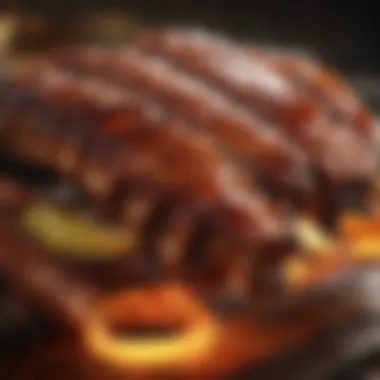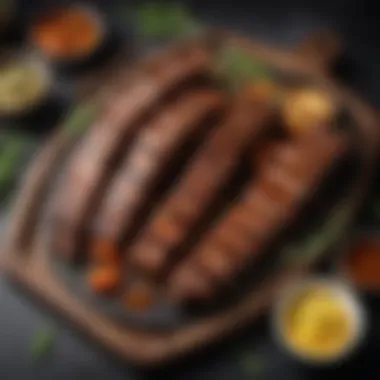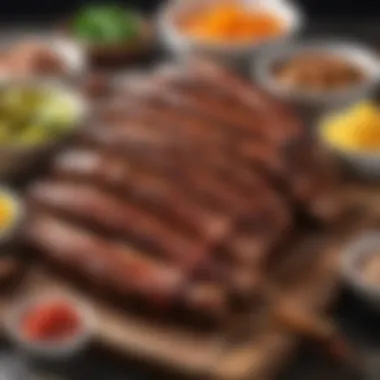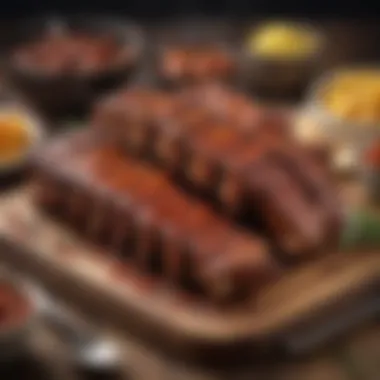Mastering BBQ Spare Ribs: Quick Oven Method


Intro
Preparing BBQ spare ribs at home can feel overwhelming, but with the right methods, it can become straightforward and rewarding. This article delves into the nuances of cooking juicy spare ribs in the oven. Focusing on busy individuals, this guide filters out the complexities and presents a step-by-step approach to preparing a delicious meal with ease. Considering the flavors, time constraints, and skill levels, this narrative offers informative insight to arm readers with the skills they need to master this dish.
Recipe Overview
- Savory Oven-Baked BBQ Spare Ribs
- Yields: 4 portions
- Prep Time: 15 minutes
- Cook Time: 2.5 hours
- Difficulty: Easy
Main Ingredients:
- 2 pounds of spare ribs
- 1 cup of barbecue sauce
- 2 tablespoons of brown sugar
- 1 tablespoon of smoked paprika
- 1 teaspoon of garlic powder
- Salt and black pepper to taste
Step-by-Step Instructions
To embark on this culinary journey, start by preparing your ingredients. Here’s how to do it:
- Prep the Ribs: Remove the membrane from the back of the ribs. This ensures they become tender during cooking. Rinse the ribs under cool water and pat them dry.
- Seasoning: In a bowl, blend the brown sugar, smoked paprika, garlic powder, salt, and black pepper. Rub this mixture generously onto both sides of the ribs. Let them sit for at least 15 minutes to absorb flavors.
- Preheat the Oven: Set your oven to 300°F (about 150°C). This low and slow method helps in breaking down the connective tissues.
- Wrap in Foil: Place the ribs on a large piece of aluminum foil with the bone side facing down, then wrap them tightly. This provides steaming action and keeps the ribs moist.
- Cooking Time: Place the wrapped ribs on a baking sheet and cook for 2 hours. After this initial phase, carefully open the foil (beware of steam) and brush the ribs with barbecue sauce. Return them to the oven, uncovering, for another 30 minutes.
- Finish and Serve: The final uncovered phase enhances the glaze of the sauce. Let the ribs rest for about 10 minutes before slicing. Serve warm with additional sauce as desired.
Time-saving Strategies and Alternatives
- Optimize by using a stand mixer for seasoning if in bulk.
- Pre-prepare the spice rub weeks in advance, stored in a sealed container.
Nutritional Information
Understanding nutritional content reinforces the healthy aspect of homemade cooking. Each portion roughly contains:
- Calories: 350
- Protein: 25 grams
- Fat: 15 grams
- Carbohydrates: 30 grams
Offers notable amounts of iron and Vitamin C mainly from the spices and barbecue sauce components.
Quick Cooking Tips
Utilize modern gadgets to enhance experiences:
- Slow Cooker or Air Fryers: Even though you may be focused on oven-based methods, both devices offer convenience and less hands-on cooking time.
- Multitasking: While cooking, consider preparing a simple side salad or heating up ready-to-eat grains like quinoa.
- Healthier Alternatives: Look for lower-sugar barbecue sauces or use alternative sweeteners that align with your dietary preferences.
Related Recipes & Variations
To elevate the meal, consider:
- Coleslaw: A crisp side dish that cuts through the richness of the ribs.
- Air Fryer Chicken Wings: Another simple and deeply satisfying dish.
- Regional Variants: Adjust spices according to local cuisines—like adding hot sauce for a kick or seasonal vegetables on the side.
Readers are encouraged to freely adapt this recipe. Every cook can encounter a unique twist based on personal tastes and local ingredient availability. Don’t hesitate to share your specific creations. The journey of mastering BBQ spare ribs doesn’t end here.
Preface to BBQ Spare Ribs
BBQ spare ribs offer a distinctive combination of flavor and tenderness. Recognizing how to prepare them adequately is essential for any culinary enthusiast. Many factors influence the quality of spare ribs, which makes understanding this topic beneficial for readers, especially those with busy lifestyles.
Understanding Spare Ribs
Spare ribs are the lower portion of the pig's rib cage. They are known for their generous meat coverage and robust flavor profile. This cut contains a higher amount of fat compared to back ribs, heightening the taste and juiciness when cooked properly. Understanding their unique characteristics will greatly enhance one’s ability to prepare delicious ribs.


With their bone structure and muscle layout, spare ribs can be tricky for newcomers. There is a slight learning curve that one will encounter when figuring out the best cooking techniques, which insures maximum flavor and tenderness. This exploration becomes vital as picking the right preparation methods can result in satisfying dining experiences at home.
The Appeal of Cooking in the Oven
Cooking BBQ spare ribs in the oven is more than just a convenient choice; it transforms how one approaches BBQ. Oven cooking offers consistent heat and temperature control, critical for ensuring that aspects such as tenderness and flavor, meat texture come out just right. The technique allows for lower monitoring requirements compared to grilling outside.
Moreover, preparing spare ribs in the oven doesn't require extensive equipment or weather considerations which can be a barrier in traditional barbecue methods. No need to worry about losing temperature during windy days, and you can even cook at any time of the year. This opens up possibilities to easily enjoy exquisite BBQ ribs without the need for outdoor space or conditions to be favorable.
Essential Ingredients for BBQ Spare Ribs
Cooking succulent BBQ spare ribs starts long before the ribs see the oven. The essential ingredients set the stage for flavor and tenderness. This section explores the specific elements that contribute to creating a mouthwatering dish fit for any occasion. Utilizing the correct ingredients not only enhances the taste but also simplifies your cooking process with predictable results.
Selecting the Right Ribs
When selecting spare ribs, variety matters. Look for ribs that have a good balance of meat and fat. Pork spare ribs are known for being larger and meatier than baby back ribs, making them an ideal choice for baking. Vital features to consider include the appearance and fat content. The meat should be pinkish and beautifully marbled, indicating both freshness and flavor potential.
It is best to avoid ribs with excessive bone structure or signs of freezer burn. Preferably, buy from a reputable butcher or grocery source. Analyzing packaging details helps too. Once your selection resonates with these characteristics, you can proceed with confidence to the next ingredient phase.
Key BBQ Marinades and Sauces
Marinades play a significant role in tenderizing meat and infusing flavor. Common options include combinations of soy sauce, vinegar, and distinct sweet elements like brown sugar or honey. Utilizing a proven reciepe can maximize taste during cooking. For those seeking originality, making your own marinade allows freedom in flavor explorations. Key components often involve:
- Vinegar: Adds acidity and kicks most recipes up a notch. It breaks down proteins in meat, enhancing tenderness.
- Sweeteners: Honey, maple syrup or molasses introduce rich contrasts to savory profiles.
- Spices: A fusion of salt, pepper, and preferred herbs creates a notable flavor base typical in good BBQ marinades.
These marinades not only elevate the taste but can also function as a storage solution. The application of sauces post-cooking can bring additional sweetness and depth.
Spices and Seasonings: What's Needed
The pursuit of well-seasoned ribs hinges on choice selection of spices. A foundation of essential spices provides a robust profile while also enjoying regional interpretations. Minimum elements to consider include:
- Paprika: Adds barrier flavor but still lends a sweet smokiness.
- Garlic Powder: Enhances overall savory notes present in ribs.
- Black Pepper: Creates gentle heat and depth.
- Cayenne Pepper: Optional but boosts character with heat.
Application involves starting with a generous sprinkle over the ribs before cooking. This simple method ensures every layer is packed with this flavor infusion. Further, adjusting personal spice levels can lead to unique experiences with every crafted rib-made venture.
Engaging with these fundamental ingredients paves a way to create a delightful BBQ experience at home.
Preparation Steps
Preparing BBQ spare ribs requires meticulous attention to several key steps. This preparation phase sets the foundation for maximizing flavor and achieving the desired tenderness. Each action plays an integral role in the overall quality of the final dish. A thorough approach at this stage leads to delicious, oven-baked ribs that impress diners.
Cleaning and Trimming the Ribs
Cleaning and trimming the ribs is an essential first step. Begin by rinsing the ribs under cold water to remove any residue. Next, trim excess fat and remove the membrane on the bone side. This membrane can hinder flavor absorption and makes ribs tough. Grasp it with a paper towel for a better grip. Once removed, the essential bones appear, ensuring more direct exposure to marinades and seasonings during cooking.
This process enhances flavor penetration and makes for a more enjoyable eating experience. A well-prepped rib has less gristle, making it tender and juicy when cooked. The care taken during this step highlights your commitment to quality cooking.
Applying the Marinade
Applying the marinade is a significant step in developing robust flavors. A good marinade has a few key components: acidic ingredients, like vinegar or citrus, oil for moisture, and various spices and sweeteners for depth. These components work harmoniously to tenderize the meat and impart it with distinct flavors. Carefully coat the ribs with a generous amount of the marinade. Use a food-safe bag or a remix large enough to ensure coverage.
It is critical to note that not all marinades are created equally. Choose something that complements your cooking style and the sauces you plan to use later. Factors like balance, sweetness, and spice level are paramount to successful outcome. The distinctive attributes of the marinade will heavily influence the taste profile of the finished dish.
Letting the Ribs Marinate


Letting the ribs marinate is often overlooked, yet it significantly impacts flavor absorption. Marination time can vary from one hour to several hours, up to overnight. Allow the ribs to rest in your refrigerator for at least two hours if you're short on time. However, longer marination will yield superior results. This process gives spices time to penetrate the meat fibers.
During marination, be sure to intermittently turn the ribs to ensure even flavor distribution. Consider the temperature of your marinade before applying it; room temperature sauces might lead to a more uniform flavor transfer compared to chilled mixes. After marinating, remove the ribs and allow excess moisture to drip off before cooking. This step prevents excess moisture from interfering with a perfect oven-sear, ensuring crispy skin.
Proper marination is crucial for developing tender, flavorful BBQ spare ribs. Make this an integral part of your preparation fluidly.
Cooking Techniques for Oven-Baked Ribs
Cooking spare ribs in the oven requires attention to detail and knowledge of specific techniques that will enhance flavor and ensure tenderness. These cooking techniques form the backbone of a successful rib dish. Mastering these methods can elevate even the most busy cook’s dinner game.
Setting the Oven Temperature
Oven temperature significantly influences the cooking process. When preparing spare ribs, setting the oven to the correct temperature is essential. Generally, cooking low and slow yields the best results. A common recommendation is to keep the oven at around 225°F to 250°F. This allows for even cooking and improves fat rendering, resulting in a moist rib that easily falls off the bone. If the temperature is too high, you risk drying out the meat. Remember that patience is key when cooking ribs.
Choosing the Right Cooking Vessel
The cooking vessel can impact cooking efficiency and final texture. Glass baking dishes, metal pans, and even cast iron skillets are suitable. However, a heavy-duty baking sheet lined with aluminum foil is often favored. This provides consistency and easy cleanup. Irrespective of choice, ensure that it is deep enough to catch juices that escape during cooking. Maintaining proper airflow around the ribs is crucial for cooking them evenly.
Foil Wrapping for Moisture Retention
One of the commonly used techniques involves foil wrapping the ribs. Wrapping them ensures they stay moist during the lengthy cooking process. It helps keep the steam generated inside, which contributes to tenderness. To utilize this technique, after seasoning, wrap the ribs tightly in aluminum foil. Ensure the seams are sealed to keep moisture trapped. This approach is often followed in the initial stages of cooking — removing the foil in later stages promotes caramelization and bark formation.
Timing and Temperature Considerations
Keeping track of both timing and temperature is important for perfect pork ribs. The cooking time generally varies based on the size of the ribs. For an average rack of spare ribs weighing approximately 2.5 pounds, expect to cook for about 3 to 4 hours at the aforementioned temperature. A meat thermometer can be particularly useful to ensure the ribs reach an internal temperature of around 190°F to 203°F, which signals they are tender enough to enjoy. Notes about timing and temperature in tandem ensure faithful results each time you prepare ribs.
Remember: Low temperature and consistent timing create delicious, tender barbecue ribs.
Achieving Desired BBQ Flavors
Flavors play a crucial role in the experience of enjoying BBQ spare ribs. Achieving a depth of taste in oven-baked ribs ensures that each bite offers succulent satisfaction. While the method of cooking may differ from traditional grilling, there are a plethora of techniques that allow the home chef to create complex and enjoyable flavors.
In oven cooking, understanding how seasonings and marinades impart flavor becomes vital. The key lies not only in what is added but also in how the ribs are treated throughout the cooking process. .""" in the heat of the oven, the flavors meld and transform, lending an unmistakable character to the dish. Both mild and bold flavors can be crafted, making it essential to enhance the cooking technique with thoughtful approaches such as basting and finishing touches under the broiler.
Basting Techniques During Cooking
Basting is the practice of applying sauce or joint juices to the ribs while they cook. This method helps foster moisture retention and adds an additional layer of flavor. The frequent application of sauce keeps the tops of the ribs well-coated. Usually, basting is done every 20-30 minutes. A brush or spoon works well for this purpose. Use the same BBQ sauce you have prepped or a blend to amplify the taste the meat absorbs.
Moreover, consider using a mixture of apple juice or broth with the BBQ sauce for extra moisture. The steam from this will also circulate within the foil wrapper, enhancing flavor and reducing any chance of dryness.
"Consistent basting can greatly improve the flavor and juiciness of your ribs. It allows the sauce to become more sticky and develops that characteristic BBQ glaze."
Finishing Under the Broiler
After the ribs are cooked gently through baking, finessing them under the broiler is a step that should not be missed. This part is paramount in achieving a caramelized crust. Set the broiler to high and place the ribs on a baking sheet lined with aluminum foil.
As the ribs are under the broiler, keep an eye on them; this step can take just a few minutes. It's here one can incorporate additional sauce. A final brushing of sauce can be applied while they are broiling to that lovely level of char. This helps to create a beautiful glaze on top, rounding out the flavors even more. Basting during this time can lead to deeper flavors and penetrative taste that can create great enjoyment upon serving.
Ultimately, the combination of strategic basting during the cooking phase along with the caramelizing under the broiler merges materials together to invoke a palette richly developed flavors, essential in making your BBQ spare ribs not just satisfying but impressive.
Serving Suggestions
When capturing the essence of BBQ spare ribs, serving suggestions play a crucial role in enhancing the overall dining experience. These ribs carry rich, savory flavors, which deserves careful consideration in a meal's composition. Appropriate accompaniments can amplify the primary taste profile while providing textural variety and refreshing contrast. An ideal meal resonates on all senses, inviting guests to not only savor the ribs but fully enjoy the entire culinary presentation.


Ideal Side Dishes for Spare Ribs
To truly complete a satisfying BBQ spare ribs experience, side dishes should be thoughtfully chosen to complement the highlighted flavors. Common well-paired sides include:
- Coleslaw: This dish introduces a refreshing crunch, balancing the richness of the ribs. The creaminess or acidity, depending on the recipe, is particularly effective at cutting through the density of the meat.
- Cornbread: Its subtle sweetness and dense texture harmonize well with the smoky spices and BBQ sauce of the ribs. A fresh slice can be a delightful addition.
- Grilled Vegetables: Seasonal vegetables such as zucchini, bell peppers, or asparagus offer lightness to the meal while supplementing vitamins and minerals, which promotes a healthier profile.
- Baked Beans: When incorporating a sweet and savory element to your plate, baked beans provide complex flavors that match perfectly with BBQ seasoning used for the ribs. Their hearty nature adds dimension to the meal.
The key with choosing ideal sides is to create balance. Rich flavors of ribs merit enlivening dishes that can equally delight the palate. Ultimately, these accompaniments should not overwhelm, rather enhance each bite taken of the tender spare ribs.
Best Pairings with BBQ Sauces
The consideration of BBQ sauces expands into mask different zest and local specialties that vary from region to region. Effective and creative pairings enhance enjoyment. Key attention is needed on:
- Sweet Sauces: Sauces made from honey, brown sugar, or molasses provide an appealing contrast to savory meats. They're particularly inviting to those new to more complex BBQ flavors.
- Vinegar-Based Choices: Options like Carolina BBQ lend a sharp tanginess that refreshes the taste buds between bites of moist pork. This sharpness proves especially useful for palate-cleansing throughout the meal.
- Spicy Variants: Chili or chipotle-infused sauces introduce heat, enhancing the savoriness of spare ribs while appealing to those who have a preference for hotter menu items. Pair them with creamy sides for balance.
- Mustard Sauces: In some regions, mustard-based sauces present a unique alternative to sweeter or spicier versions. This out-of-the-ordinary combination may intrigue adventurous diners seeking dflavor exploration.
Pairing is not merely about matching sauces with meat. One must consider the aggregate flavors on the plate as a whole. Each drizzle or splash of sauce extenuates the lifting experience, making each bite of spare ribs notably dynamic as reactions occur.
Memory of taste sometimes holds as much importance as the food itself; offer varieties and creative combinations to build an event around BBQ spare ribs rather than a simple meal.
Managing Leftover Ribs
Managing leftover ribs is an integral area not to overlook. After the effort and time put into crafting delicate BBQ spare ribs, it feels good to know you can extend this satisfaction beyond a single meal. This section delves into why proper management of leftover ribs matters and how implementing certain techniques creates further convenience and reduces waste.
Importance of Proper Storage and Use
When leftover ribs are not carefully stored, they can quickly lose their robust flavor and tenderness. Inefficiencies in managing leftovers lead to wasted food and financial resources. Understanding effective storage methods safeguards the original quality and provides you with an effortless meal option later on.
Storage Tips for Cooked Ribs
Put aside time to ensure your now leftover ribs remain appetizing for tomorrow's mealtime. Follow these key strategies to enhance longevity and taste:
- Cool Down Before Storing:
Allow the ribs to return to room temperature before placing them in your refrigerator. This helps prevent premature spoilage. - Use Airtight Containers:
Choose quality airtight containers or heavy-duty aluminum foil. This prevents air from entering and keeps moisture locked in. The ideal option is vacuum-sealing, which removes most of the air completely. - Label Your Storage:
Keep track of how long the ribs have been stored by labeling them with both the date and content. This ensures they will be consumed in the right time frame. - Refrigeratewithin a Couple of Hours:
To follow food safety guidelines, make the transfer to the refrigerator no later than two hours after cooking. Keeping cooked ribs within a refrigerator helps maintain optimum temperature. - Reheat Gently:
When ready to consume your leftover ribs, reheat carefully. Use a low oven temperature or stove to prevent drying out. Slowly warming them will keep them juicy and tender.
Creative Recipes for Leftovers
Leftover ribs can transcend being a mere snack—there are innovative recipes to experiment with that breathe new life into yesterday's meal.
- BBQ Rib Tacos:
Finely chop the leftover meat and mix it with your favorite BBQ sauce. Serve in corn tortillas adorned with fresh veggies and topped with a drizzle of lime for a zesty twist. - Rib Fried Rice:
Allow your creativity to flourish. Stir-fry cooked rib meat with rice, peas, and really any vegetables on hand for a quick meal. Toss in soy sauce just prior to serving for additional flavor. - Rib Sandwiches:
Pull off the meat and layer them onto a hearty bun, add coleslaw, and a rebuilt sandwich becomes an instant classic BBQ pleasure.
Leftover BBQ ribs are not simply about finishing a meal but providing an opportunity to unlock endless culinary creativity.
Utilizing leftover ribs adeptly can enrich your culinary experience. Emphasizing both storage and versatile recipe ideas contributes significantly to the kitchen convenience, thus ensuring no remnants go to waste and remain a source of joy.
Epilogue
Recap of Steps and Techniques
Starting with the preparation steps, consider this a sequential journey to oven-baked perfection. First, the proper selection of spare ribs ensures a quality meal. Then, thorough cleaning and trimming enhance not only taste but also the texture of the final dish. The right marinades and application process further integrate flavors deep into the meat.
Here’s a brief recap:
- Select Right Ribs: Choose the best quality spare ribs available.
- Clean and Trim: Remove any excess fat or silverskin for better texture.
- Apply Marinade: Allow for sufficient marination time for deeper flavors.
- Monitor Cooking Techniques: Utilize foil wrapping to lock in moisture.
- Finish with Broiling: A crispy layer enhances the oven-baked ribs.
These steps ensure that each bite is filled with depth of flavor and mime see the satisfied balance of tender meat.
Final Thoughts on Convenience Cooking
Cooking in the oven provides many triumphs for culinary enthusiasts with limited time. You do not just save time; you also control the cooking process. Using an oven offers convenience in terms of space and heat regulation. It eliminates uncertainties that come with outdoor grilling or complex cooking methods.
When properly executed, oven-baked spare ribs can rival those cooked on a grill, showcasing juicy and flavorful meat. By mastering convenient cooking methods in your kitchen, you can elevate everyday meals. Online forums like reddit.com serve as further inspiration where cooks share tips and experiments.
Preparing BBQ spare ribs this way comes down to personal enjoyment along with quality food. Hence, it's an opportunity to indulge flavors without excessive effort, making it suitable for both busy days and leisurely meals at home.







